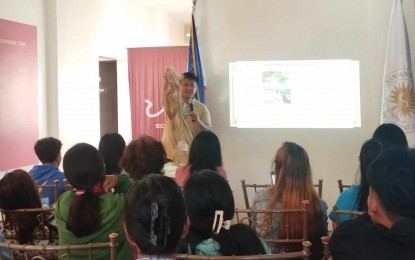Abaca fiber production in Bicol gets support from DA’s fiber industry office

(Photo by Angelica Serrano, OJT/PNA)
LEGAZPI CITY — The Philippine Fiber Industry Development Authority in Bicol (PhilFIDA-5) is promoting fiber production in Bicol.
In an interview on Tuesday, Brent Baltazar Marbella, PhilFIDA-5 fiber development officer, said they help farmers by linking them directly to processors and providing training on high-quality fiber production.
“We are providing our abaca farmers’ group or associations with direct access to processors or buyers so that they can discuss the right price and the demand needed,” Marbella said.
“We provide technical training on abaca production from establishment to processing and harvesting,” he noted.
“We also continue to give free planting materials, provision of farm equipment, a particular stripping knife, and a spindle stripping machine,” he added.
Marbella said they coordinate with local government units and other national government agencies for financial grants and assistance for the farmers.
“The price of abaca fiber depends on the grade, [which] ranges from P45 to P55 per kilogram for [a] fair grade, while good to excellent goes up to P120 per kilogram,” he said.
The agency has submitted a funding proposal to its mother agency, the Department of Agriculture, for the rehabilitation of the abaca plantation destroyed by the weather disturbances Kristine and Pepito in 2024.
In the Bicol Region, Catanduanes leads in fiber production, making 81 percent of all abaca produced in the region, followed by Albay with 11 percent, Camarines Sur with 4 percent, Sorsogon with 1 percent, and Camarines Norte with 0.5 percent.
Abaca demo, training
Meanwhile, the National Museum of the Philippines in Bicol (NMP-Bicol) conducted a two-day workshop about abaca processing and weaving for female participants from Sorsogon as part of its Women’s Month celebration.
In an interview also on Tuesday, Jesseshan Aycocho, NMP-Bicol information officer, said the activity aims to highlight women’s capacity to extract abaca fiber in the abaca industry, which is traditionally a male-dominated industry.
“If you have observed earlier, we have two women hand-strippers manually extracting abaca fiber through the traditional abaca hand-stripping device,” she said.
“We saw that it’s a laborious task. But of course, in celebration of women’s month, we want to show our participants and the public that women can also do it,” she pointed out.
Aycocho said since Bicol is one of the largest producers of abaca, it is important to showcase the tangible and intangible cultural heritage attached to abaca.
(With reports from Angelica Joyce Serrano and Lily Nocomora, OJTs/PNA)